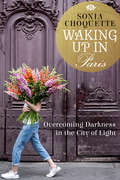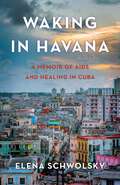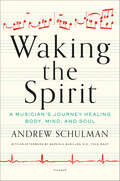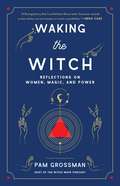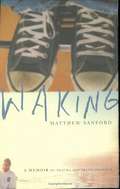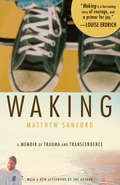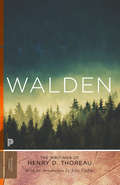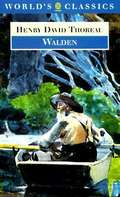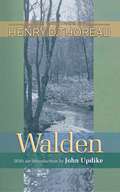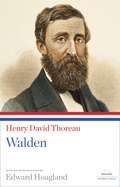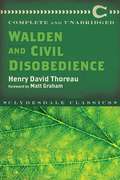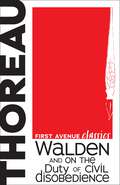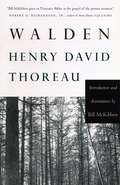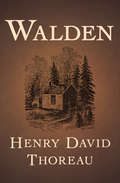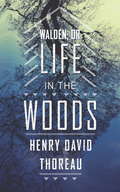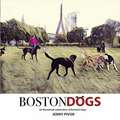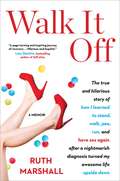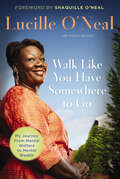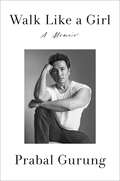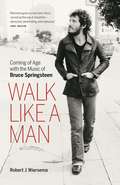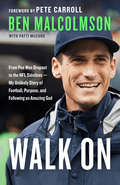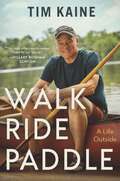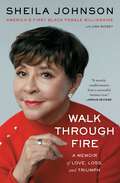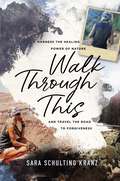- Table View
- List View
Waking Up in Paris: Overcoming Darkness in the City of Light
by Sonia Choquette"As if waking up from a nightmare, I thought, If I am going to be traumatized, I might as well be traumatized in Paris, right?"Devastated by the unexpected end of her decades-long marriage, renowned spiritual teacher and intuitive guide Sonia Choquette undertook an equally unexpected move and relocated to Paris, the scene of many happy memories from her life as a student and young mother. Arriving in the aftermath of the Charlie Hebdo massacre, she found a Paris as traumatized by this unforeseen event as she had been by her divorce. Together, over the following years, she and the city she loves began a journey of healing that involved deep soul-searching and acceptance of new, sometimes uncomfortable, reality.In this follow-up to Walking Home, Sonia shares her intimate thoughts and fears, as well as the unique challenges of setting up a new life in a foreign land. From moving into a freezing, malodorous apartment, to a more pleasant —yet haunted —flat across the Seine, to her current light-filled home, Sonia shares how these changes parallel her inner transformation.Along the way, Sonia regales readers with vivid stories of her unfortunate encounters with French hairdressers and beauticians, her adventures in French fashion, and her search for the perfect neighborhood café. Her companion throughout is the city of Paris —a character unto itself —which never ceases to fill her with wonder, surprise, and delight, and provides her with the spiritual strength to succeed in establishing her new life.
Waking in Havana: A Memoir of AIDS and Healing in Cuba
by Elena SchwolskyIn 1972, when she was a young, divorced, single mother, restless and idealistic, Elena Schwolsky made a decision that changed her life: leaving her eighteen-month-old son with his father, she joined hundreds of other young Americans on a work brigade in Cuba. They spent their days building cinderblock houses for workers and their nights partying and debating politics. The Cuban revolution was young, and so were they. At a moment of transition in Schwolsky&’s life, Cuba represented hope and the power to change. Twenty years later, she is drawn back to this forbidden island, yearning to move out of grief following the death of her husband from AIDS and feeling burned out after spending ten years as a nurse on the frontlines of the epidemic. Back in Cuba, she experiences the chaotic bustle of a Havana most Americans never see—a city frozen in time yet constantly changing. She takes readers along with her through her humorous attempts to communicate in a new language and navigate this very different culture—through the leafy tranquility of the controversial AIDS Sanitorium and into the lives of the resilient, opinionated, and passionate Cubans who become her family and help her to heal.
Waking the Spirit: A Musician's Journey Healing Body, Mind, and Soul
by Andrew SchulmanAn Oliver Sacks Foundation Best Book of the Year Selection, Finalist for the Books for a Better Life "Best First Book” Award, and a People Magazine Pick in nonfiction.The astounding story of a critically ill musician who is saved by music and returns to the same hospital to help heal othersAndrew Schulman, a fifty-seven-year-old professional guitarist, had a close brush with death on the night of July 16, 2009. Against the odds—and with the help of music—he survived: a medical miracle.Once fully recovered, Andrew resolved to use his musical gifts to help critically ill patients at Mount Sinai Beth Israel’s ICU. In Waking the Spirit, you’ll learn the astonishing stories of the people he’s met along the way—both patients and doctors—and see the incredible role music can play in a modern hospital setting.Schulman expertly weaves cutting-edge research on neuroscience and medicine, as well as what he’s learned as a professional musician, to explore the power of music to heal the body and awaken the spirit.
Waking the Witch: Reflections on Women, Magic, and Power
by Pam GrossmanA whip-smart and illuminating exploration of the world’s fascination with witches from podcast host and practicing witch Pam Grossman (The Witch Wave), who delves deeply into why witches have intrigued us for centuries and why they’re more relevant now than ever. When you think of a witch, what do you picture? Pointy black hat, maybe a broomstick. But witches in various guises have been with us for millennia. In Waking the Witch, Pam Grossman explores the cultural and historical impact of the world’s most magical icon. From the idea of the femme fatale in league with the devil in early modern Europe and Salem, to the bewitching pop culture archetypes in Buffy the Vampire Slayer, Sabrina the Teenage Witch, and Harry Potter; from the spooky ladies in fairy tales and horror films to the rise of feminist covens and contemporary witchcraft, witches reflect the power and potential of women. In this fascinating read that is part cultural analysis, part memoir, Pam opens up about her own journey on the path to witchcraft, and how her personal embrace of the witch helped her find strength, self-empowerment, and a deeper purpose. A comprehensive meditation on one of the most mysterious and captivating figures of all time, Waking the Witch celebrates witches past, present, and future, and reveals the critical role they have played—and will continue to play—in shaping the world as we know it.
Waking: A Memoir of Trauma and Transcendence
by Matthew SanfordThis memoir about a car accident that ended the lives of two of the author's family members and rendered the author a paraplegic describes how the surviving family members picked up the pieces of their lives, his recuperation at the Mayo Clinic, and his decision to become a disabled yoga instructor.
Waking: A Memoir of Trauma and Transcendence
by Matthew SanfordMatthew Sanford's inspirational story about the car accident that left him paralyzed from the chest down is a superbly written memoir of healing and journey—from near death to triumphant life.Matt Sanford's life and body were irrevocably changed at age 13 on a snowy Iowa road. On that day, his family's car skidded off an overpass, killing Matt's father and sister and left him paralyzed from the chest down, confining him to a wheelchair. His mother and brother escaped from the accident unharmed but were left to pick up the pieces of their decimated family.This pivotal event set Matt on a lifelong journey, from his intensive care experiences at the Mayo Clinic to becoming a paralyzed yoga teacher and founder of a nonprofit organization. Forced to explore what it truly means to live in a body, he emerges with an entirely new view of being a "whole" person. By turns agonizingly personal, philosophical, and heartbreakingly honest, this groundbreaking memoir takes you inside the body, heart, and mind of a boy whose world has been shattered. Follow Sanford's journey as he rebuilds from the ground up, searching for "healing stories" to help him reconnect his mind and his body. To do so, he must reject much of what traditional medicine tells him and instead turn to yoga as a centerpiece of his daily practice. He finds not only a better life but also meaning and purpose in the mysterious distance that we all experience between mind and body.In Waking, Sanford delivers a powerful message about the endurance of the human spirit and of the body that houses it.
Walden
by Henry D. ThoreauOne of the most influential and compelling books in American literature, Walden is a vivid account of the years that Henry D. Thoreau spent alone in a secluded cabin at Walden Pond. This edition--introduced by noted American writer John Updike--celebrates the perennial importance of a classic work, originally published in 1854. Much of Walden's material is derived from Thoreau's journals and contains such engaging pieces from the lively "Where I Lived, and What I Lived For" and "Brute Neighbors" to the serene "Reading" and "The Pond in the Winter." Other famous sections involve Thoreau's visits with a Canadian woodcutter and with an Irish family, a trip to Concord, and a description of his bean field. This is the complete and authoritative text of Walden--as close to Thoreau's original intention as all available evidence allows. This is the authoritative text of Walden and the ideal presentation of Thoreau's great document of social criticism and dissent.
Walden
by Henry David Thoreau Stephen FenderIn 1845 Henry David Thoreau began a new life, spending most of each week for over two years in a rough hut he built himself on the northwest shore of Walden Pond, just a mile and a half from his home town of Concord, Massachusetts. Walden is Thoreau's autobiographical account of this experiment in solitary living, his refusal to play by the rules of hard work and the accumulation of wealth and, above all, the freedom it gave him to adapt his living to the natural world around him. This new edition traces the sources of Thoreau's reading and thinking and considers the author in the context of his birthplace and his sense of its history - social, economic, and natural. In addition, an ecological appendix provides modern identifications of the myriad plants and animals to which Thoreau gave increasingly close attention as he became acclimatized to his life at Walden. Long-revered by political reformers and environmentalists, Walden is here reassessed by Stephen Fender, whose edition is based on research into the material conditions of Thoreau's life in Concord, and the town's place in the history of mid-nineteenth-century New England. [This text is listed as an example that meets Common Core Standards in English language arts in grades 11-12 at http://www.corestandards.org.]
Walden
by Henry David Thoreau<P>To celebrate the 150th anniversary of the original publication of Thoreau's classic work (which is cited in Books for College Libraries, 3rd ed.), this special edition is published in cooperation with the Walden Woods Project, a nonprofit organization founded in 1990 to preserve the land, literature, and legacy of Thoreau. The text includes a brief introduction by E. O. Wilson. <P>[This text is listed as an example that meets Common Core Standards in English language arts in grades 11-12 at http://www.corestandards.org.]
Walden
by Henry David ThoreauIn 1845 Henry David Thoreau left his pencil-manufacturing business and began building a cabin on the shore of Walden Pond near Concord, Massachusetts. This lyrical yet practical-minded book is at once a record of the 26 months Thoreau spent in withdrawal from society -- an account of the daily minutiae of building, planting, hunting, cooking, and, always, observing nature -- and a declaration of independence from the oppressive mores of the world he left behind. Elegant, witty, and quietly searching, Walden remains the most persuasive American argument for simplicity of life clarity of conscience. For the first time, the authoritative editions of works by major American novelists, poets, scholars, and essayists collected in the hardcover volumes of The Library of America are being published singly in a series of handsome paperback books. A distinguished writer has contributed an introduction for each volume, which also includes a chronology of the author's life and career, an essay on the text, and notes. From the Trade Paperback edition.
Walden and Civil Disobedience (First Avenue Classics Ser.)
by Henry David Thoreau Matt GrahamPackaged in handsome, affordable trade editions, Clydesdale Classics is a new series of essential works. From the musings of academics such as Thomas Paine in Common Sense to the striking personal narrative of Harriet Jacobs in Incidents in the Life of a Slave Girl, this new series is a comprehensive collection of our intellectual history through the words of the exceptional few.First published in 1854, Walden was written by the renowned transcendentalist Henry David Thoreau about his experience living off the land at Walden Pond for more than two years. Thoreau divides his deliberations and meditations into a variety of sections which include his views on economy and the natural world, the importance of reading and literature, the values of both solitude and companionship, and other personal reflections. In addition to Walden, this edition also includes Thoreau’s essay on Civil Disobedience, which discusses his views on the nature of government and its negative effects on society.With a new foreword by survivalist Matt Graham, venture into the woods with Thoreau and explore the complexities of life and truth in this classic piece of American literature.
Walden, and On the Duty of Civil Disobedience (First Avenue Classics ™)
by Henry David ThoreauIn these two American literary classics, Henry David Thoreau offers readers his experiences and thoughts on how to live a more fulfilling life and stand up for what is right. Having spent two years living in solitude at Walden Pond, he stresses the importance of a quiet, reflective life and the rewards of a nonmaterialistic existence in Walden. His essay "On the Duty of Civil Disobedience" discusses his belief in nonviolent protests against an unjust government—in particular, he attacks the US government's approval of slavery and support for the Mexican-American War. These unabridged versions were first published in 1854 and 1849, respectively, but their ideas are timeless.
Walden: Introduction and Annotations by Bill McKibben (Concord Library)
by Henry David Thoreau Bill MckibbenFirst published in 1854, Henry David Thoreau's groundbreaking book has influenced generations of readers and continues to inspire and inform anyone with an open mind and a love of nature. With Bill McKibben providing a newly revised Introduction and helpful annotations that place Thoreau firmly in his role as cultural and spiritual seer, this beautiful edition of Walden for the new millennium is more accessible and relevant than ever. [This text is listed as an example that meets Common Core Standards in English language arts in grades 11-12 at http://www.corestandards.org.]
Walden: Large Print
by Henry David Thoreau<P>An American masterwork in praise of nature, self-reliance, and the simple lifeI went to the woods because I wished to live deliberately, to front only the essential facts of life, and see if I could not learn what it had to teach, and not, when I came to die, discover that I had not lived. <P>In 1845, the transcendentalist Henry David Thoreau moved from his home in the town of Concord, Massachusetts, to a small cabin he built by hand on the shores of Walden Pond. <P>He spent the next two years alone in the woods, learning to live self-sufficiently and to take his creative and moral inspiration from nature. P <P>art memoir, part philosophical treatise, part environmental manifesto, Walden is Thoreau's inspirational account of those extraordinary years and one of the most influential books ever written.
Walden; Or Life in the Woods
by Henry David ThoreauA multi-faceted classic of American literature and philosophy. At the beginning of the book, Thoreau leaves his civilized life behind, planning to live in the wilderness for two years to discover what a simpler, purer life has to offer him. He builds a home for himself near Walden pond, and begins on a journey of discovery. Throughout the course of the book Thoreau mixes in-depth explanations of how he lived with reflective musings on what his life of tranquility, simplicity, and closeness with nature taught him. Penguin Random House Canada is proud to bring you classic works of literature in e-book form, with the highest quality production values. Find more today and rediscover books you never knew you loved.
Walk In My Shoes
by ed. Charlotte J. DewittUsher Syndrome is a rare genetic disease that causes deafblindness. This anthology includes 27 authors writing about their experiences.
Walk It Off: The True and Hilarious Story of How I Learned to Stand, Walk, Pee, Run, and Have Sex Again After a Nightmarish Diagnosis Turned My Awesome Life Upside Down
by Ruth MarshallFuriously Happy meets Elaine Lui in this truly original—and surprisingly hilarious—memoir about one woman’s journey to learn how to walk after a debilitating diagnosis turned her life upside down.Learn How to Walk (Again) To-Do List: Step 1: Stand Step 2: Step Step 3: Pee (Yes!) Step 4: Walk with walker Step 5: Walk with sticks Step 6: Walk without props Recreational interlude for sex Step 7: RUN! Ruth Marshall—power mom, wife, actor, and daughter—was in great health, until one day, her feet started to tingle. She visited doctors and specialists for tests, but no one could figure out the cause of her symptoms. Was she imagining those pesky tingles? She tried to brush it off, even as she tripped over curbs and stumbled into people. Clumsiness is charming, right? But when Ruth suddenly couldn’t feel her legs at all, she knew something was terribly wrong. Her fears were confirmed by an MRI revealing a rare tumour that had been quietly growing on her spine for more than a decade. Within days, surgery was scheduled, and after the intense eight-hour ordeal, Ruth woke up to find her legs and feet had forgotten how to do...well, everything. The question that burned in her mind was, “Will I ever walk again?” What Ruth thought would be three days in the hospital turned into months of rehabilitation as she relearned not only how to walk, run, pee, and even have sex again, but how to better appreciate everyone around her—including her devoted husband, her two young sons, her worried parents, her sisters, her loving friends, and the caring staff at the rehab center who help her tackle her recovery head-on. Laugh-out-loud outrageous and searingly honest, this is a memoir that not only entertains but inspires readers to put their best foot forward and walk off anything life throws their way.
Walk Like You Have Somewhere to Go: My Journey from Mental Welfare to Mental Health
by Allison Samuels Lucille O'Neal“In Walk Like You Have Somewhere to Go Lucille will take you on a 40-year journey from ‘mental welfare to mental wealth.’ You will laugh—you may cry—and in the process you will be encouraged, enlightened, and empowered.”—Paula White, author of Dare to Dream: See Yourself as God Sees You As the mother of one of the greatest athletes of all time, her journey is exceptional; but her story reveals that she is more than just “Shaquille O’Neal’s mom.”Lucille O’Neal is a woman you know, a woman you understand. Perhaps your own journey resembles hers. O’Neal has been a rebellious teen, a single mother, a wife, a college student, a divorcée, and, above all, a woman of unique courage. Acquainted early in life with turmoil, O’Neal’s circumstances shaped her perspective and strengthened her resolve to overcome the challenges she would encounter later in life. She has endured poverty, rejection, abuse, addiction, and the illness of a child, yet today her faith and compassion for others are stronger than ever. O’Neal writes candidly—and often humorously—about her years of spiritual unrest and mental warfare, and her return to the God of her childhood.In Walk Like You Have Somewhere to Go, O’Neal shares her struggles and disappointments against the backdrop of her sweetest memories and proudest accomplishments. After fifty-five years, O’Neal has gained the wisdom to recognize her wrongs and guide others down a different path. Her story is proof that it’s never too late for a new beginning.
Walk Like a Girl: A Memoir
by Prabal GurungFrom acclaimed fashion designer Prabal Gurung comes a captivating, courageous literary memoir, a testament to the transformative power of creativity, and a celebration of the power of femininity and individualityWalk Like a Girl is the story of a queer boy who yearned for a world beyond the confines of prejudice he experienced growing up in Nepal and India. He came to New York, a hopeful immigrant lured by the siren song of the American Dream, only to encounter pernicious discrimination as he rose within the glossy world of New York high society and high fashion. Chronicling his rise to success as a fashion designer, Prabal reveals the inner workings of this beautiful, treacherous, rarefied world—and what it takes to survive. With brutal honesty, Prabal takes us on a journey from Nepal to New York, and from the harrowing experiences that shaped him to his inspiring, hard-won ascent to the designer he is today, dressing American icons like Oprah Winfrey, Michelle Obama, and Kamala Harris.Walk Like a Girl is also an ode to Prabal&’s mother, Durga Rana, whose unwavering love and support gave him the courage to be unapologetically himself. To understand that the things people wanted to shame out of him were, paradoxically, his superpowers. A defiant anthem for the soul, Walk Like a Girl is an invitation to rewrite your story. To shatter the mold into which society has tried to cast you. When we learn to embrace the power of vulnerability, the beauty of imperfection, and the infinite possibilities within each of us, we begin to see the extraordinary power within ourselves, waiting to be unleashed.
Walk Like a Man
by Robert J. WiersemaThere are dozens of books about the Boss, exploring every facet of his career. So what's left to say? Nothing objective, perhaps. But when it comes to music, objectivity is highly overrated. Robert Wiersema has been a Springsteen fan since he was a teenager. By most definitions, he's a fanatic: following tours to see multiple shows in a row, watching set lists develop in real time via the Internet, ordering bootlegs from shady vendors in Italy. His attachment is deeper than fandom, though: he's grown up with Springsteen's music as the soundtrack to his life, beginning with his working-class youth in rural British Columbia and continuing on through dreams of escape, falling in love, and becoming a father.Walk Like a Man is liner notes for a mix tape, a frank and inventive blend of biography, music criticism, and memoir over the course of thirteen tracks. Like the best mix tapes, it balances joy and sorrow, laughter seasoning the dark-night-of-the-soul questions that haunt us all. Wiersema's book is the story of a man becoming a man (despite getting a little lost along the way), and of the man and the music that have accompanied him on his journey.
Walk On: From Pee Wee Dropout to the NFL Sidelines--My Unlikely Story of Football, Purpose, and Following an Amazing God
by Pete Carroll Ben Malcolmson Patti McCordIn this true, compelling account of perseverance and hope from Seahawks Coach Pete Carroll's assistant, a young journalist walks on to a top-ranked USC football team and, guided by his faith, shares God's love, launching him on an unexpected journey with an amazing outcome.Had anyone told Ben Malcolmson that he'd someday be a wide receiver on the national champion USC football team--after not playing football since an unfortunate fifth-grade Pop Warner experience--he would have called them crazy. As a reporter for The Daily Trojan, in the spirit of George Plimpton, he participated in walk-on tryouts for the team and was dumbfounded to find himself listed on the roster. His position on the team never amounted to much in a game-time contribution, but Ben felt strongly that his faith was inextricably linked to his purpose. He felt called to anonymously place Bibles in each USC teammate locker on Christmas Eve--to resounding indifference and rejection from his friends. It wasn't until three years later, when his role at USC had led to a role with Coach Pete Carroll at the Seahawks organization, that an old friend connected with Ben and told him that one of the Bibles had captivated the heart of a teammate in the three days before his death. With a humble spirit dedicated to consistent acts of discipleship, Ben Malcolmson is an authentic voice for the power of simple obedience and trust, for what can happen when a believer allows God to work in a life. Walk On is the result of God using his faithful people to work in the lives of others.
Walk Ride Paddle: A Life Outside
by Thomas NelsonA compelling account of one man&’s journey across hundreds of miles of Virginia wilderness and a moving testament to the optimistic spirit of America, Walk Ride Paddle provides an unseen glimpse into a life outside. In 2019, Tim Kaine—Virginia senator and former Democratic vice presidential candidate—commemorated both his sixtieth birthday and his twenty-fifth year in public office by undertaking a three-part journey across the Virginia landscape as he hiked, cycled, and canoed across the state. His chronicle became an organic reflection of the extraordinary events occurring across America during that time, including two impeachment trials, a global pandemic, growing racial protests, the January 6 attack on the Capitol, and more.During weekends and in Senate recess weeks, Kaine—over a period of several years—hiked the 559 miles of the Appalachian Trail that cross Virginia from Harpers Ferry to the Tennessee border; biked 321 miles along the crest of the Virginia Blue Ridge on the beautiful parkways built during the Great Depression to create jobs and give everyday people on the East Coast an accessible place to vacation; and canoed the entire James River—348 miles from its headwaters in the Allegheny Mountains to its entrance into the Chesapeake Bay. Along the way, Kaine reflected on the events that have shaped both his life and the world around him, sharing his deep love for the natural world and the importance of preserving it for future generations in a fascinating memoir that blends adventure, reflection, and political insight.With immediacy and honesty, Kaine pulls back the curtain to reveal his inner thoughts during such monumental times. Kaine&’s storytelling gift and wise observations offer a fascinating glimpse into the mind of a seasoned politician and outdoor enthusiast.Walk Ride Paddle is a captivating memoir of one man&’s physical journey through the Virginia wilderness—but it is also a unique and ultimately optimistic perspective on these pivotal moments in history, offering inspiration, wisdom, and hope.
Walk Through Fire: A Memoir of Love, Loss, and Triumph
by Sheila JohnsonThe cofounder of BET and first African American woman billionaire shares her deeply personal journey through love and loss, tragedy and triumph—an inspiring story of overcoming toxic influences, discovering her true self, and at last finding happiness in her work and life. From humble beginnings as a schoolgirl and young violinist in Maywood, Illinois, Sheila Johnson rose to become one of the most accomplished businesswomen in America. A cofounder of Black Entertainment Television, she became an entrepreneur and philanthropist at the highest levels. But that success came at a painful personal cost. Sheila grew up in a middle-class family that encouraged her love of the arts and music. But her idyllic childhood ended at age sixteen when her beloved father announced he was leaving for another woman, an act that shattered her mother and destroyed Sheila&’s trust. She vowed she&’d never be in her mother&’s position—dependent on a man for her sense of self-worth and for financial security. Yet when she was barely out of her teens, Sheila married a man who would take her right down that same unfortunate path. Filled with sharply drawn, emotionally powerful scenes, Walk Through Fire traces the hardships Sheila faced in her marriage and her professional life. Despite her skills as a violinist and music teacher, as well as her obvious entrepreneurial talent, she had to fight to overcome self-doubt and fears of failure. Sheila vividly details her struggles, including battling institutional racism, losing a child, suffering emotional abuse in her thirty-three-year marriage, and plunging into a deep depression with her divorce. And yet, out of that pain came renewed purpose and meaning. In the third act of her life, Sheila Johnson has not only made her mark as the founder of Salamander Hotels & Resorts and the only Black female co-owner of three professional sports teams, she has also, finally, found true love. Walk Through Fire is a uniquely American success story. And it is the deeply personal portrait of one woman who, despite heartache and obstacles, finally found herself and her place in the world.
Walk Through This: Harness the Healing Power of Nature and Travel the Road to Forgiveness
by Sara Schulting KranzHit the trail with Sara Schulting Kranz, life coach and certified wilderness guide, as she shares her story of forgiveness and healing, and provides a path forward for those who have suffered setbacks or trauma.In Walk Through This: Harness the Healing Power of Nature and Travel the Road to Forgiveness, Sara shares a step-by-step handbook that shows readers how to reconnect with nature--wherever they may be--and begin their healing journey. You&’ll be equipped with tools to use along the way, such asFoundational information about nature deficit disorder and the negative impact it has on our minds and bodiesExercise prompts to help you evaluate where you are on the path and check your progress along the wayMeditations to guide you deeper into the processEveryone has the capacity to forgive and to heal. All you need to do is take that first step . . .
